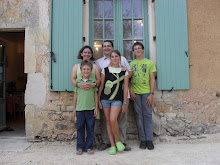
Our cat, Caline, is two years old now. As we celebrated her birthday we tried out some IQ tests to see how she was doing. The children set up a timed test.
‘Caline, here’s your dinner!’ (Cat runs across room and eats food one minute later)
‘Caline, vien manger ton dîner!’ (Cat runs across room and eats food two minutes later)
They decide she replies faster to English, probably because four of us always speak English to her. It seemed weird to speak my second language to an animal, and the children simply followed suit, even though she joined our household as a six-month-old kitten from a French family. The cat does have a role to play though. She is a shining example of the one cat-one language strategy, because now Marc, Nina and Gabriel all speak English to the cat. She meows in return and conversations can go on for quite some time. They even made up special songs for her.
My French friend, Corinne, lives in Scotland and just adopted a kitten from a French family who were moving home. Her two children also follow the one-cat-one-language policy and only talk in French to the cat. Corinne is happy to hear them using more of her language and reports that the kitten loves the kids chatting to her. The OCOL approach may not be high level language use, being rather limited in subject matter (food, water, mice, birds, the weather), but at least it gives children a chance to use the minority language with a willing and purring listener.



No comments:
Post a Comment